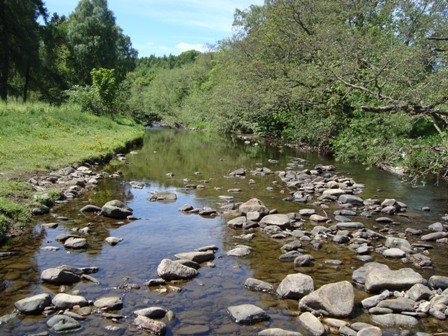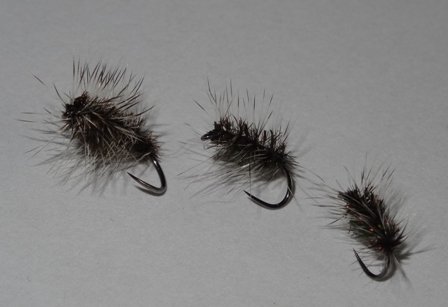| Back to Back Issues Page |
 |
|
Dog days July 12, 2018 |
Dog Days
First fish early! And I mean for a couple of hours before breakfast. Trout are active and feeding at first light as many predators are. My go to at this time is a double nymph rig with silver beads on a French leader and fishing the deepest fastest runs on the river. These may be in short supply in drought conditions which means trout may be to use one of my colloquialisms “packed in there like sardines”. The supply of oxygen is critical for trout survival and cooler (deeper) water holds more than shallow warmer water. Any area that combines deeper faster water with tree cover deserves special attention and early morning is a fantastic time to fish. I set my nymph rig with a DBS/Flash UV caddis and a 3 mm Black magic nymph on the dropper about 25 inches above the point. Distance from the point to the bead indicator on the onstream-guide.com nymphing leaders is about 5 feet. I’m actively seeking water 2-4 feet moving at faster than walking pace with distinctive seams if possible. Then fish late but change tactics and get on the surface with dries. Evening is time for an abundant number of exhausted egg laying mayfly to finally succumb to death and fall on the watercourse that gave it life and contribute to the food chain. This is often by being eaten by a trout. This is the essence of sex, death and fly fishing of John Gierach fame. Summer evening fishing is epitomised by calm evenings and a fine and far off approach in low water usually brings rewards. Often we have to drop fly sizes and fish a diminutive Griffiths gnat on a size 20 to get a take. The onstream-guide fly “the one” featured on our DVD is a perfect fly in these circumstances. The one is derived from an impressive number of anglers who only use a single dry fly pattern which is almost always a grey duster or variation thereof. The one is a paraloop grey duster and is a perfect imitation of those dead and dying Mayfly trapped in the surface film that those porpoising brown trout take. Other great under Tree patterns are the “F” terrestrial and the Griffiths gnat is perfect in a midge hatch. If you fish late in the Evening on Summer rivers be sure to carry the Lifejacket Caddis in both sizes. Not only can you fish a small nymph under it at range you may if you are lucky witness and fish a caddis hatch. This results in explosive takes and trout bow waving under the surface chasing the pupae. It can be extremely exciting and every fly fisherman should experience this at least once in their career.
The Griffiths gnat a go to dry fly on low riversFinally change environment and fish. Dog days in July/August you are as likely to find me along a couple of my quiet secret spots on the Northumberland coast catching mackerel on the fly as on a trout stream. Fantastic hard fighting abundant fish and perfect conditions are high tides and high pressures. A cool sea breeze is the perfect anecdote to the high humidity in land. And if brown trout are the metaphorical aquatic leopards then mackerel are the aquatic tigers. The beach casting fraternity with 3-4 lb plus test curve rods cannot possibly do these fish justice. Get them on a 5 weight fly rod and they make you whoop! Great fish for eating and curing/smoking as well. You need a fast sinking or lead cored line and any white lure such as a minkie. If the fish are really abundant they hit the fly on the drop- just watch the line and if it jolts as it sinks as it sinks set the hook. Otherwise hand over hand retrieve and don’t expect subtle takes. I hope to see many of you at various upcoming demonstrations including our annual outing to Leekwork Caravan Site on the upper Tees 1st and 2nd September. Hope to see you there. Contact Leekworth for details. http://www.caravancampingteesdale.co.uk/ Regards, Jonathan. |
| Back to Back Issues Page |

